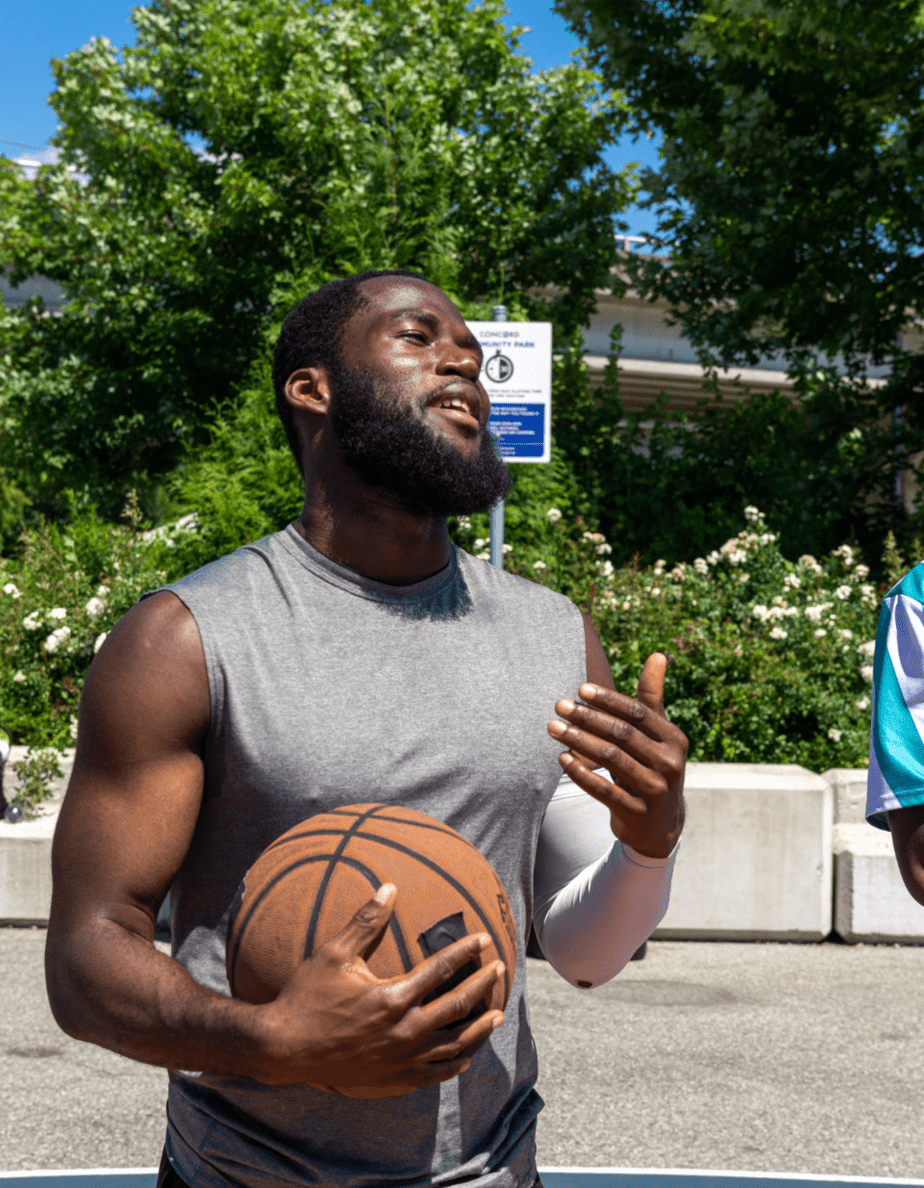Basketball Size Chart: By Age, Gender, Weight and PSI
Why would you even need a basketball size chart? Well, if you are like me with kids going through growth spurts you want to keep them in the right basketball for their size as they grow into a full-size ball. In basketball, if you want to teach the proper techniques for dribbling, passing, and shooting you want the right size ball for the player.
Having the wrong ball can be frustrating for you and your little basketball player. Using the wrong size ball is one of the most common equipment errors when training.
A basketball size chart can serve as a quick reference for making the right choice according to the age and gender of the player. Let’s get right to the chart (below):
| Size | Radius | Weight | PSI Range | Used By |
|---|---|---|---|---|
| Size 7 | 29.5″ | 22 oz | 7.5 to 8.5 | NBA, men’s college, and high school basketball leagues |
| Size 6 | 28.5″ | 20 oz | 7.5 to 8.5 | Women’s high school, college, and professional basketball leagues |
| Size 5 | 27.5″ | 17 oz | 7.5 to 8.5 | Boys and girls ages 9-11 |
| Size 4 | 25.5″ | 14 oz | 7.5 to 8.5 | Boys and girls ages 5-8 |
| Size 3 | 22″ | 10 oz | 7.5 to 8.5 | Boys and girls ages 4-8 |
| Size 1 | 16″ | 8 oz | 7.5 to 8.5 | Boys and girls ages 2-4 |
Why Basketball Size Is Important
Like anything in life, we need an excellent fit to feel comfortable.
Basketball is a game of small margins, and just a couple of inches between sizes can make all the difference. These items will apply regardless of whether you are looking for an indoor basketball or an outdoor basketball or a hybrid made of leather or rubber.
Comfort and Enjoyability
If youth basketball players can comfortably grow in the sport through practice and diligence, they are more likely to stick with it.
If they feel like they struggle even to pick up the ball, much less show any sort of aptitude, they’ll feel disheartened.
That’s what happens when 9-, 10-, and 11-year-olds try to play with a pro ball.
Many well-meaning parents will purchase the size 7 ball, used in most men’s professional basketball associations, as they think that using the “same ball the pros use” will get their child more excited about the sport.
Unless that child has the strength and form necessary to handle that large of a ball, it very well might do the exact opposite.
Proper Technique
When youth basketball players start their training, the habits and skills they develop will follow them into adulthood.
If a child plays with a too-large basketball, they can develop some unhealthy habits to compensate for the size. These are often difficult or impossible to break as they get older.
At almost double the weight of a size 5 basketball, a size 7 ball is too heavy for a younger player to handle safely or effectively.
That extra weight infringes on how well they learn the fundamentals of shooting.
Players learn to tilt their wrists back with the ball balanced on their fingertips as they enter the shooting stance. A too-heavy ball for the player handling it will pull the wrist backward further than is comfortable, making it difficult to achieve the ideal “flick” motion necessary to shoot effectively.
They may also learn that it’s easier to deliver power from both hands, using their non-shooting hand to add force behind their shot.
Because they are forcing their guide hand forward instead of keeping it stationary, they add more directional force to the ball, which can ruin their backspin and send the ball straight out instead of in an arc.
Too large of a ball can also affect their ability to dribble, as a youth player’s hands are not large enough to place their fingertips across enough of the ball’s surface area.
Instead, they will often resort to flat-palm dribbling, which means stunted development of ball control.
Basketball is a game of small margins, and those couple of inches between sizes can make all the difference in helping a kid love the game or throwing their hands up in frustration.
Deciding Which Basketball Size Is Right
Choosing the right basketball size, especially for youth players, is critical for their development and enjoyment of the game.
The size of the ball should grow with them, adding more circumference and weight as they hone their motor skills, strengthen their muscles, and up their game.
Youth players should not be playing or practicing with official size seven balls until they are 13 or older, at which point they have the muscle strength to handle the ball without risking injury.
How Big Is A Size 3 Basketball?
Size 3 is considered a mini ball. These weigh less than half that of a size 7 ball, so very young players can handle them easily while playing and practicing.
You won’t see these in any official capacity, but their 10oz weight and 22” circumference make this mini ball ideal for children aged 4-8.
If your little one is on a local team, where they play with lowered nets, this is most likely the size they’re using.
How Big Is A Size 4 Basketball?
A step up from the mini ball is another introductory option for blossoming ballers. The size 4 ball is 25.5” and weighs 14oz, making it a lighter, more friendly entry-level ball for players aged 5-8.
It’s a popular choice for parents who want to introduce the sport at home before their children can play on school or intramural teams because its size is easily manageable with smaller hands.
How Big Is A Size 5 Basketball?
At 27.5” around and weighing in at 17oz, the size 5 basketball or “junior” ball is the standard basketball size for boys and girls aged 9-11. It’s just the right size for future pros who are starting to explore organized school or community teams.
How Big Is A Size 6 Basketball?
Introduced in 1977, the size 6 is the middle ground between the youth ball and the men’s pro ball. At 28.5” and 20oz, it’s a smaller, lighter option and the same women’s basketball size used by female professional basketball players in the WNBA and FIBA.
The basketball size 6 is also appropriate for boys aged 12-14, as its smaller size makes it easier to control while they are still developing more advanced techniques and muscle control.
How Big Is A Size 7 Basketball?
This is the OG basketball, the same as the NBA basketball size, as well as FIBA, and the Olympics. It’s the largest, heaviest ball at a full 29.5” inches around and weighing in at 22oz.
When learning fundamentals, a child under 15 should not use a basketball size 7 for play or practice. Once a male player has reached the age of 15, they can upgrade to the largest size.

How Do You Tell If a Basketball is Fully Pumped?
You may not always have a quality air pressure gauge but a trick basketball referees and coaches often use is to hold the ball up to face level and let it drop by free fall. The bottom of the ball should bounce up past your waistline or a little higher. If the basketball bounces up to the chest or higher you need to take a little air out and if does not bounce up to the waistline you need to give it a little more air.
Wrapping Up
One of the best things you can do to kindle a child’s love for basketball is to ensure they are playing with equipment appropriately sized for their age.
A basketball size chart by age can help parents choose the proper basketball size for their youth players.
Girls and boys aged 4-8 will do best with the lighter, smaller size 3 and size 4. It will help them learn how to control a ball and some basic shooting and dribbling techniques.
Size 5 basketballs are a good fit for any youth player aged 9-11. They’re heavier but proportional to the average hand size and strength of someone that young.
Size 6 is the official basketball size of the WNBA and an intermediary size for male teens before they upgrade to the pro size 7 at 15.
Troy Wright
I am a lifetime basketball enthusiast and loved playing basketball competitively through high school. I still try and play at least 3 times a week and explore all kinds of equipment and training to keep myself on the court and continually getting better. I am a college basketball fanatic and move onto the NBA when March Madness ends.
Meaningful conversations happening daily about training, recovery, and injury-specific rehabilitation as well as sport-specific discussions on playing, coaching and refereeing your favorite sport. We welcome experts and those with curious minds seeking answers.
Join The Stay On The Court Community!
